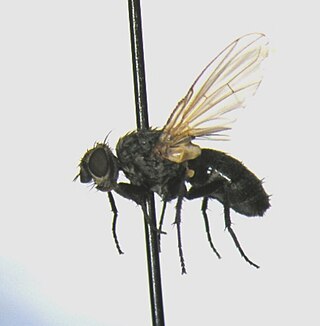The Entomological Society of America (ESA) was founded in 1889 and today has more than 7,000 members, including educators, extension personnel, consultants, students, researchers, and scientists from agricultural departments, health agencies, private industries, colleges and universities, and state and federal governments. It serves the professional and scientific needs of entomologists and people in related disciplines. To facilitate communication among members, the ESA is divided into four sections based on entomological interests, and six branches, based on geographic proximity. The national office is located in Annapolis, Maryland.

The southern hairy-nosed wombat is one of three extant species of wombats. It is found in scattered areas of semiarid scrub and mallee from the eastern Nullarbor Plain to the New South Wales border area. It is the smallest of all three wombat species. The young often do not survive dry seasons. It is the state animal of South Australia.
Hoogstraal's gerbil is distributed mainly in southwestern Morocco. There are thought to be less than 250 individuals in existence.

Bison latifrons, also known as the giant bison or long-horned bison, is an extinct species of bison that lived in North America during the Late Pleistocene epoch ranging from southern Canada to Mexico. It is noted for large body size and its distinctive long horns.

The Mexican vole is a species of vole.

The Sifton Bog Environmentally Significant Area is a wetland jointly administered by the city of London, Ontario and the Upper Thames River Conservation Authority. It is located west of Hyde Park Road and south of Oxford Street inside the city limits of London, Southern Ontario, Canada. It is a Class 2 provincially significant wetland.
Calliphora latifrons is a species of blue bottle fly.
Dichocera is a genus of flies in the family Tachinidae.

Phytomyptera is a genus of flies in the family Tachinidae.
Plagiocephalus huberi is a species of ulidiid or picture-winged fly in the genus Plagiocephalus of the family Ulidiidae.
Plagiocephalus lobularis is a species of ulidiid or picture-winged fly in the genus Plagiocephalus of the family Ulidiidae.

The Gibberichthyidae, also known as gibberfishes, are a small family of deep sea stephanoberyciform fish, containing a single genus, Gibberichthys, and two species. Found in the tropical western Atlantic, western Indian, and western and southwestern Pacific Oceans at depths of about 400-1,000 m, gibberfishes are of no economic importance. The maximum recorded size for either species is 12 centimetres (4.7 in) standard length.

Ramonda is a subgenus of flies in the family Tachinidae.
The Southwestern Entomologist is a quarterly peer-reviewed scientific journal published by the Society of Southwestern Entomologists. It was established since 1976 and is a regional publication covering entomological research conducted primarily in Texas, Oklahoma, New Mexico, and Mexico. It is published in English, with optional abstracts in Spanish.
The Society of Southwestern Entomologists was founded as the Southwestern Entomological Society in 1976 with the objective of fostering entomological accomplishment in the southwestern United States and Mexico. The society's name was changed in 2003 to avoid confusion with the Southwestern Branch of the Entomological Society of America, with whom they meet annually. A primary function of the Society is the publication of the journal Southwestern Entomologist, published quarterly in March, June, September and December.

Cervalces latifrons, the broad-fronted moose, or the giant moose was a giant species of deer that inhabited the Europe and Asia during the Pleistocene epoch. It is thought to be the ancestor of the modern moose, as well as the extinct North American Cervalces scotti. It was considerably larger than living moose, placing it as one of the largest deer to have ever lived.

Nothodelphax is a genus of delphacid planthoppers in the family Delphacidae. There are more than 20 described species in Nothodelphax.
Microcentrum latifrons, the southwestern angle-wing katydid, is a species of phaneropterine katydid in the family Tettigoniidae. It is found in North America.
Namibiana latifrons, also known as the Benguela worm snake or Sternfeld's threadsnake, is a species of snake in the family Leptotyphlopidae. It is endemic to the southwestern coast of Angola.

Richardia telescopica is a species of flies from the genus Richardia. The species was originally described by Gerstaecker in 1860 and it occurs in Nicaragua, Costa Rica, and Panama.









